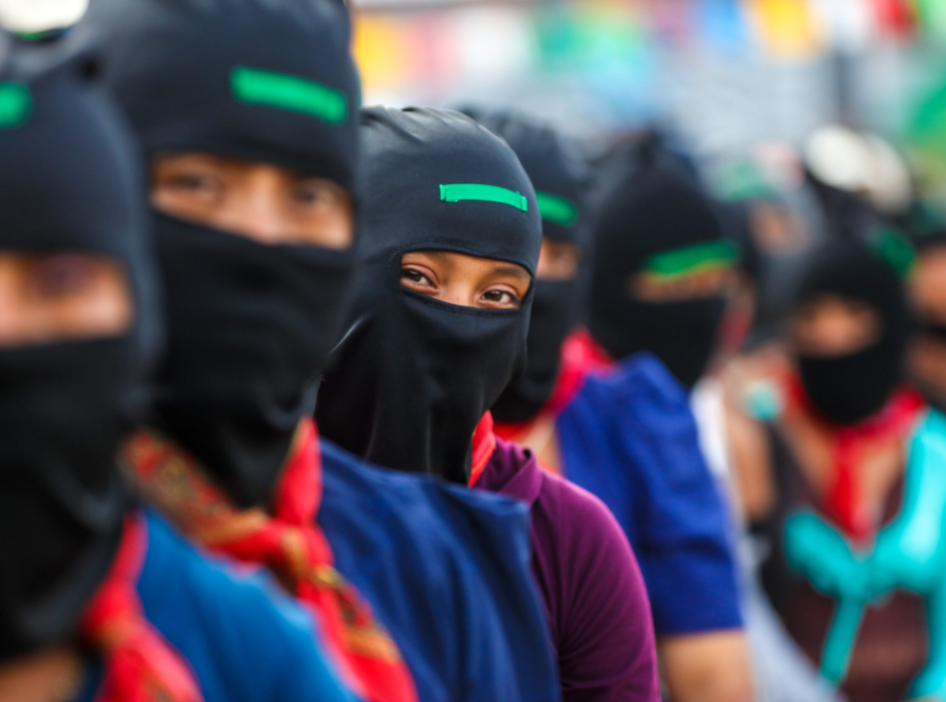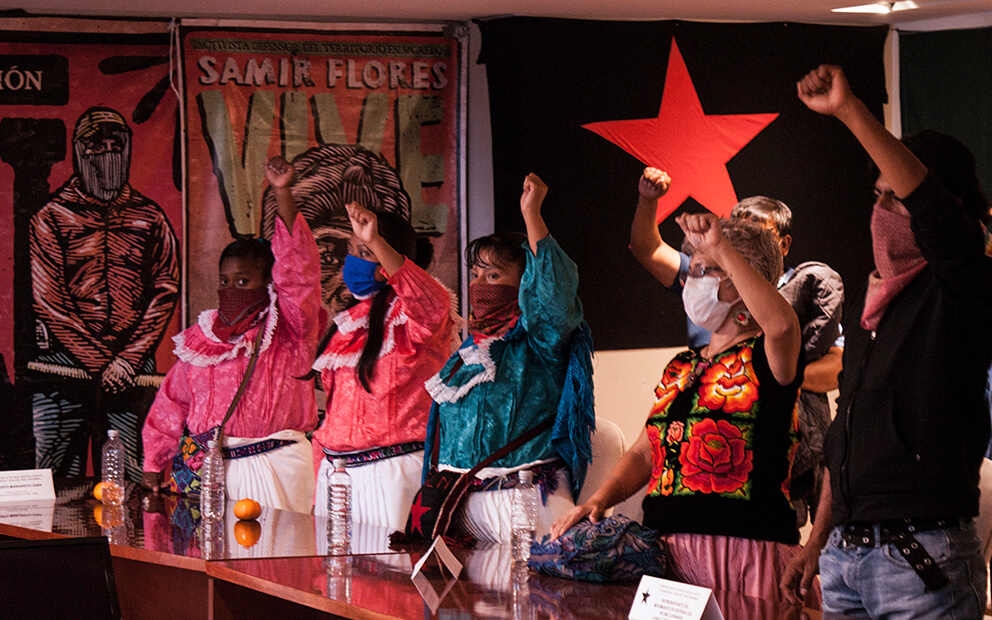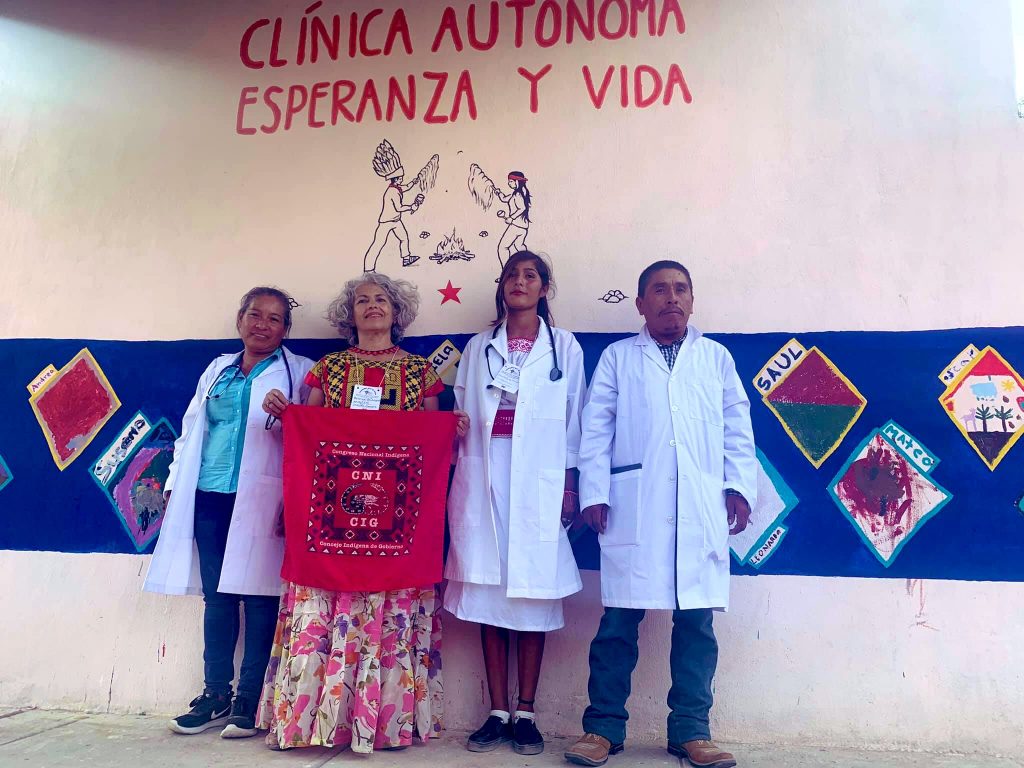
Photo: Daliri Oropeza in Pie de Página
by Raúl Romero
In Mexico: A Cartography of War (https://bit.ly/36dXO3G) (see translation here), we mapped out some urgent problems in our country. There were two points of departure: 1) The energy, extractive and infrastructure megaprojects that are being built in the national territory, and 2) The many violences that have been unleashed by the expansion of criminal economies. These phenomena have spanned different six-year periods, as well as the emergence of organizations that are resisting war and dispossession. Moved by different causes, these organizations are building pockets of resistance and sometimes even zones free from dispossession and organized crime, and although they are not exempt from harassment and persecution by the real and formal powers, they continue to build bridges and construct a cartography of hope.
Networks of solidarity with migrants extend throughout the nation. In Tenosique, Tabasco, there is La 72, a home-shelter for migrants promoted by the Franciscan Province of San Felipe de Jesús. It is named in memory of the 72 migrants murdered in 2010 in Tamaulipas, so La 72, in feminine form, is also a refuge-altar. In Veracruz there are Las Patronas, a group of women who for 27 years have organized themselves to prepare food and give it to migrants. The work they do is truly amazing, delivering up to 300 lunches a day. In Mexico City, you can find spaces such as Casa Tochán, or La Resistencia Café or the solidarity of the neighbors of the Santo Domingo neighborhood in Coyoacán. We must mention the work of the Jesuit Migrant Service, or La Pequeña Haití, a neighborhood of people of Haitian origin that was built in Tijuana. The work carried out by the Regional Network of Migrant Families, the Caravan of Migrant Mothers and the Mesoamerican Migrant Movement is worthy of note.
Facing the lack of efficient responses from the Mexican State to take care of the problem of the missing person, the families have launched the search for their loved ones, with the most basic of resources. There are the Relatives in Search María Herrera; the Searching Mothers of Sonora; the Trackers of El Fuerte, en Sinaloa; the Voice of the Disappeared of Puebla, the Until We Find You Collective, in Guanajuato; the Families of Ayotzinapa, en Guerrero; the women of United Forces for Our Disappeared, in Nuevo León, Jalisco, Coahuila and in other states; the Solecito Collective, en Veracruz and a hundred more organizations that along with the other resistances are endowing this injured society with dignity and hope.

The increase and brutality of patriarchal violence has also given rise to the strengthening and weaving of solidarity and resistance efforts among women. They are all over the country, accompanying, reflecting and building alternatives. Some examples are the Red de Feminismos Descoloniales (Decolonial Feminisms Network), which reflects, acts and networks with other organizations. There are also Las Siemprevivas, a women’s collective that accompanies cases of violence, disappearances and femicides. In some cases they form cooperatives, such as the Vendaval bread cooperative or spaces such as the Volcana/ Lugar común bookstore and social center.
It is the indigenous peoples who maintain the most robust organizations. The Zapatistas in Chiapas, with its 43 autonomous entities (Caracoles, municipalities and Centers of Resistance and Rebellion), is one of the most advanced experiences of autonomy in the world. With the recovery of land that they have carried out throughout their existence, they have managed to create schools, hospitals, cooperatives, housing, communication media, and a long etcetera. The Tepehuana and Wixárika communities of San Lorenzo de Azqueltán in Jalisco also stand out, as they have defended their territory and created an autonomous clinic. The Nahua people of Santa María Ostula, in Michoacán, are also part of this creative resistance with the recovery of their territories and the strengthening of their community guard. There is also the town of Amilcingo which is resisting the Morelos Integral Project, and which sustains the Samir Flores Soberanes elementary school and Radio Amiltzinko 100.7 FM.

Many other experiences are yet to be mapped in this cartography, such as the efforts of cooperatives like La Imposible, La Carabina 30-30, La Ordeña, CACAO, or the collective housing work of the Organización Popular Francisco Villa de Izquierda Independiente (Francisco Villa Popular Organization of the Independent Left), of Tlanezi and Xochitlanezi, of the Frente del Pueblo Resistencia Organizada, of the Otomí Community in Mexico City, or the interesting initiative of Casa Temilco, in Amatlán, Morelos, or the work of the Brigada Callejera de Apoyo a la Mujer “Elisa Martínez.” What is important to highlight is that in the face of the war and dispossession that the system of domination and exploitation deploys in our country, there are a multitude of resistances. They are the territories where fundamental battles are being fought. As the vocal Zapatista Subcomandante Moisés says: resistance is to become strong, tough, to have a response to everything, any one of the attacks of the enemy, of the system, you see. That is creative resistance.
This article was published in La Jornada in on February 27th, 2022. https://www.jornada.com.mx/2022/02/27/opinion/014a1pol English translation re-published by Schools for Chiapas.
